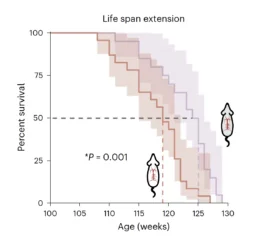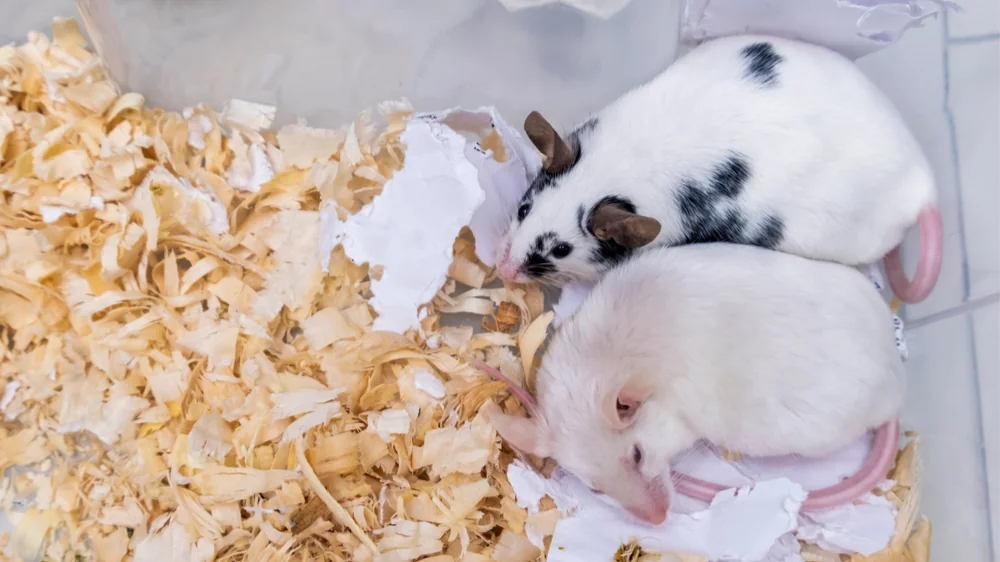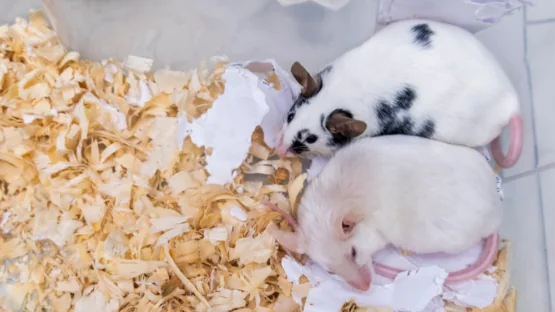For the first time, scientists have shown that letting young and old mice share blood leads to a significant lifespan extension in the old mouse [1].
Rejuvenation by young blood
Since the dawn of civilization, young blood has been credited with healing and rejuvenating powers, and its value has been demonstrated by modern science. In recent years, studies into heterochronic parabiosis, pioneered by Irina and Michael Conboy, have shown that stitching together circulatory systems of a young and an old animal leads to signs of rejuvenation in the latter, at the expense of its young counterpart [2].
Yet, until now, there have been no studies of the effects of heterochronic parabiosis on lifespan, mainly due to the lack of detachment protocols. Testing lifespan properly involves safely detaching the animals and determining when the older one dies of age-related diseases.
Significant lifespan extension
This new study, published in Nature Aging and authored by prominent geroscientists such as Steve Horvath and Vadim Gladyshev, does just that. The researchers report successfully detaching heterochronic pairs, testing them immediately upon detachment and two months later, and determining the remaining lifespan of the older mice.
The mice were divided into three groups: old isochronic pairs (that is, both mice stitched together were old), young isochronic pairs, and heterochronic pairs. Each of those groups was divided into two subgroups, with one undergoing a three-month parabiosis protocol, and the other one undergoing a shorter five-week version that is used in existing studies. The older mice were 20 months old, and the younger ones were three months old.
The main result was a significant six-week extension of median lifespan and a two-week extension of maximum lifespan in the older mice that underwent long-term heterochronic parabiosis compared to the isochronic controls.

Epigenetic and transcriptomic rejuvenation
The researchers measured the mice’s biological age using several different methylation clocks and two independent methylation sequencing platforms. Immediately upon detachment, old mice in heterochronic pairs showed a robust methylation age reduction of 24% compared to old isochronic pairs. Importantly, this effect lingered even two months after detachment (22.4%). Comparable results were seen in the liver (17% age reduction immediately after the detachment and 19% two months later), showing that rejuvenation affected solid organs as well. With the shorter five-week protocol, the effects were less prominent.
In heterochronic parabiosis, the surgery and the involuntary cohabitation themselves are potent stressors that can affect the animals’ health. However, the researchers did not detect any difference in epigenetic age between the old parabionts and untreated controls of the same age, which shows that surgery itself had no effect on the epigenome.
The researchers had to exclude another possible confounding factor: the relative lack of physical activity in parabiosis pairs. They developed a model of mock parabiosis in which the animals were attached together but their circulation systems remained apart. Those pairs did not exhibit an increase in methylation age compared to non-paired controls, which means that the lack of activity did not make parabionts epigenetically older.
An analysis of gene expression in the liver showed that older heterochronic parabionts experienced substantial upregulation of pathways related to oxidative phosphorylation and mitochondrial biogenesis (i.e, cellular energy production), and downregulation of inflammatory response genes. Those changes were largely sustained after the two-month detachment.
Both the transcriptomic and epigenetic profiles of old heterochronic parabionts clustered between those of young and old mice, but much closer to the former, suggesting robust rejuvenation. Here, too, the effects of the shorter treatment were much weaker.
Comparisons to other anti-aging interventions
The researchers then compared the changes in gene expression induced by heterochronic parabiosis to those associated with known anti-aging interventions, such as caloric restriction. They found a strong positive association with four out of five intervention signatures.
However, the similarity decreased during the post-detachment period. The effects of short-term parabiosis, while still noticeable, were much smaller. “Heterochronic parabiosis in old mice”, the researchers note, “seems to counteract aging by activating genes related to metabolism and cellular respiration while inhibiting the inflammatory response, like other longevity interventions.”
Among individual genes, the researchers noticed upregulation of Sirt3 and of Gstt2. The latter is involved in the production of glutathione, the main antioxidant in the body. Both of these genes are also upregulated by many other anti-aging interventions.
Interestingly, the researchers also saw a significant increase in the Tert gene, which encodes telomerase reverse transcriptase, an enzyme that keeps telomeres long. Its overexpression was recently shown to increase lifespan in mice [3]. The researchers concluded that their findings “indicate that what we observed is in fact multi-omic, systemic and sustained biological rejuvenation.”
Literature
[1] Zhang, B., Lee, D. E., Trapp, A., Tyshkovskiy, A., Lu, A. T., Bareja, A., … & White, J. P. (2023). Multi-omic rejuvenation and life span extension on exposure to youthful circulation. Nature Aging, 1-17.
[2] Huffman, D. M., Csiszar, A., & Ungvari, Z. (2021). Heterochronic blood exchange attenuates age-related neuroinflammation and confers cognitive benefits: do microvascular protective effects play a role?. GeroScience, 43, 111-113.
[3] Jaijyan, D. K., Selariu, A., Cruz-Cosme, R., Tong, M., Yang, S., Stefa, A., … & Zhu, H. (2022). New intranasal and injectable gene therapy for healthy life extension. Proceedings of the National Academy of Sciences, 119(20), e2121499119.





